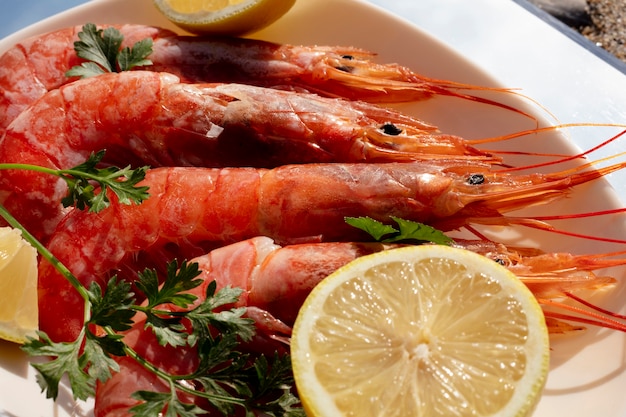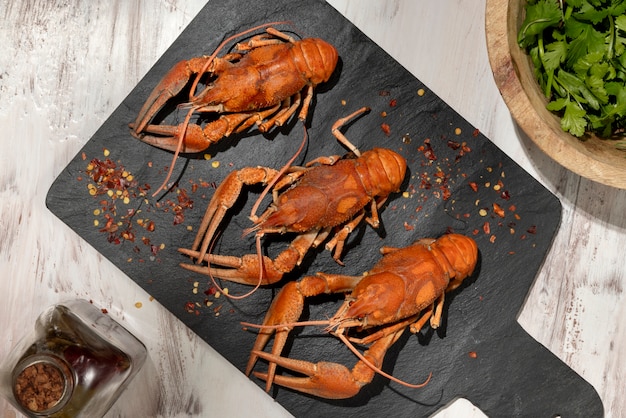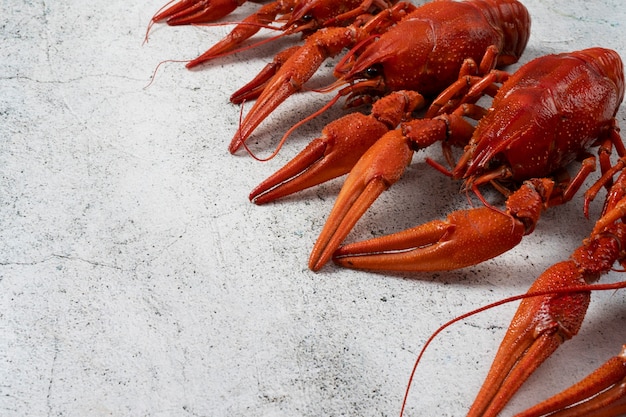Alright, so you've got yourself some frozen red king crab legs, eh? You're probably thinking, "How on earth do I cook these things without turning them into rubber?" Don't worry, my fellow seafood enthusiast, because I'm here to guide you through the delicious journey of bringing those frozen crustaceans to life.
I've been a seafood fanatic for as long as I can remember, and red king crab legs are right up there with my absolute favourites. The succulent meat, the satisfying crack of the shell, the glorious, sweet, and briny taste – it's all just pure culinary bliss! But over the years, I've learned that cooking frozen crab legs is a bit of an art form. It's not just about throwing them in a pot of boiling water and hoping for the best.
So, grab a comfy seat, pour yourself a nice glass of something refreshing, and let's dive into the world of delicious red king crab legs, shall we?
Part 1: choosing the right crab Legs

Let's face it, choosing the right crab legs is the first step to a fantastic culinary experience. You want to make sure you're getting the best possible quality, so you end up with a delicious meal that's worth bragging about.
Frozen vs Fresh: A Quick Comparison
You might be wondering, "Should I go for frozen or fresh?" And you know what? It's a valid question! While fresh crab legs are undeniably a treat, frozen ones are usually more convenient and often more affordable.
Fresh Crab Legs: Fresh crab legs, if you can find them, offer the ultimate freshness and flavour. They're a real delicacy, with the most vibrant taste and delicate texture. However, they tend to be more expensive, and their shelf life is much shorter. You'll need to cook them within a day or two of getting them, which can be tricky if you don't have a plan.
Frozen Crab Legs: Frozen crab legs are a fantastic alternative. They offer great value for your money, a longer shelf life, and the convenience of having them readily available. You can usually find frozen crab legs at most supermarkets, and they'll last for months in your freezer. The key here is to choose quality frozen crab legs, and I'll give you some tips on how to do that in a bit.
Looking for Quality Frozen Crab Legs
I've learned a thing or two about picking out good frozen crab legs over the years. Here's what I look for:
Freshness: Look for crab legs that are brightly coloured, with a vibrant red hue. This indicates that they were frozen quickly after being caught, preserving their freshness. Avoid any that appear dull or discoloured, as this might mean they've been frozen for a long time.
No Ice Crystals: The packaging should be free of excessive ice crystals, which can indicate that the crab legs have been frozen and thawed multiple times. This can compromise their quality, making them less juicy and flavorful.
Firm Texture: The crab legs should be firm to the touch, not mushy or soft. If they're mushy, it could mean they've been thawed and refrozen, or they haven't been properly handled during the freezing process.
Origin: If you're feeling adventurous, check out the origin of the crab legs. Different regions are known for different flavours and qualities. For example, Alaskan red king crab legs are highly prized for their sweet and succulent meat.
Part 2: Preparing Your Crab Legs

Now that you've got your beautiful red king crab legs, it's time to get them ready for cooking. We need to make sure they're thawed properly and ready to be transformed into a delicious meal.
Thawing the Crab Legs
You can thaw your crab legs in the refrigerator overnight, which is the gentlest and most recommended method. This allows the crab legs to thaw slowly and evenly, preserving their texture and moisture.
If you're short on time, you can also thaw them in cold water. Just make sure the water is cold enough to prevent the crab legs from cooking prematurely. Place the frozen crab legs in a sealed bag or container and submerge them in cold water. Change the water every 30 minutes or so to ensure it stays cold.
Whatever method you choose, avoid thawing them at room temperature, as this can lead to bacterial growth and make the crab legs unsafe to eat.
Cleaning and Removing the Shell
Once your crab legs are thawed, you're ready to clean them. I find it easier to do this after cooking, but you can also do it before.
Rinse the crab legs: Give them a good rinse under cold water to wash off any debris. This will ensure that any loose particles are removed before cooking.
Remove the bands: You'll find some bands holding the legs together. These are usually made of plastic or rubber. You can simply cut them off with a pair of kitchen shears.
Part 3: Cooking Methods

Now comes the exciting part: cooking your glorious red king crab legs! There are a few tried-and-true methods that I love, each offering a unique flavour and texture.
Steaming
Steaming is my personal favourite method for cooking crab legs. It's simple, gentle, and preserves the delicate flavour of the crab.
Equipment: You'll need a steamer basket that fits into your pot. You can find these at most kitchen supply stores.
Water Level: Fill the pot with about an inch of water. Don't fill it too high, as you don't want the water to touch the crab legs directly.
Steaming Time: Steam the crab legs for about 8-10 minutes per pound. Adjust the cooking time depending on the size of the legs. Smaller legs will cook faster, while larger legs will need a bit longer.
Flavour Boost: For a flavour boost, you can add some herbs like bay leaves, thyme, or parsley to the water. This will infuse the steam with a delightful aroma and add a subtle flavour to the crab meat.
Boiling
Boiling is another quick and easy method. Just make sure not to overcook your crab legs, or they'll become tough and rubbery.
Equipment: Use a large pot with plenty of water. Make sure the pot is large enough to hold the crab legs without overcrowding them.
Boiling Time: Boil the crab legs for about 5-7 minutes per pound. Again, adjust the cooking time depending on the size of the legs.
Seasoning: You can add salt, pepper, and a few bay leaves to the water for extra flavour. This will help to season the crab meat as it cooks.
Grilling
grilling crab legs adds a smoky flavour and delightful char, giving them a unique taste and texture. Just be careful not to let the legs burn.
Equipment: Preheat your grill to medium heat. Make sure your grill grates are clean and well-oiled to prevent the crab legs from sticking.
Cooking Time: Grill for about 5-7 minutes per side. Flip the crab legs halfway through the cooking time to ensure even cooking.
Seasoning: Brush the crab legs with melted butter or olive oil and season with salt, pepper, and garlic powder. This will add flavour and help to prevent the crab legs from drying out.
Baking
Baking crab legs gives them a crispy texture and allows for various flavour combinations. You can create delicious baked crab legs with different herbs and spices.
Equipment: Preheat your oven to 400°F (200°C).
Cooking Time: Bake for about 15-20 minutes. Place the crab legs on a baking sheet lined with parchment paper to prevent sticking.
Seasoning: You can toss the crab legs in butter, herbs, and spices before baking. Some popular combinations include garlic butter, lemon pepper, or paprika.
Using a slow cooker
For a hands-off approach, you can use a slow cooker to cook your crab legs. This method is perfect for a busy day when you need to leave the cooking to the appliance.
Equipment: Use a slow cooker on low heat.
Cooking Time: Cook for about 4-6 hours. The slow cooker will gently cook the crab legs, ensuring that they are tender and flavorful.
Seasoning: You can add butter, lemon juice, garlic, and herbs to the slow cooker. This will infuse the crab legs with delicious flavours as they cook.
Part 4: Serving Your Crab Leg Feast
Now that your crab legs are cooked to perfection, it's time to serve them up! A beautiful presentation can really elevate your crab leg feast, making it more enjoyable for you and your guests.
Presentation Matters
A beautiful presentation can enhance the dining experience.
Serving Platter: Arrange your crab legs on a large platter. Use a platter that's big enough to comfortably hold all the crab legs without overcrowding.
Garnish: Add some sprigs of parsley, lemon slices, or a few sprigs of dill for a touch of colour and fragrance. This will add a visual appeal and enhance the aroma of your crab legs.
side dishes: Consider serving your crab legs with some delicious side dishes, like a simple salad, mashed potatoes, or garlic bread. These side dishes will provide a balance of flavours and textures, complementing the crab legs.
Tools for Cracking and Enjoying
crab crackers: These handy tools help you crack the shells without making a mess. They're specifically designed for breaking open crab shells, making it easier to get to the delicious meat inside.
Crab Forks: These smaller forks are perfect for extracting the meat from the shell. They're designed to be small and nimble, allowing you to easily maneuver them between the delicate meat and the shell.
Napkins: You'll definitely want plenty of napkins on hand. Eating crab legs can get a little messy, so having plenty of napkins readily available is a must.
Part 5: Delicious Ways to Enjoy Your Crab Legs
There are so many fantastic ways to enjoy your red king crab legs! Here are a few of my favourites, ranging from classic to creative.
Classic Steamed with Butter
steamed crab legs, drizzled with melted butter, are the epitome of simple and delicious. The fresh, briny flavour of the crab shines through, and the butter adds a lovely richness, highlighting the natural sweetness of the crab meat.
Lemon and Garlic Butter
This flavour combination is a winner. The lemon brightens the flavours, while the garlic adds a wonderful depth, creating a vibrant and aromatic sauce. Simply melt some butter with minced garlic and a squeeze of lemon juice. You can also add a pinch of red pepper flakes for a touch of heat.
Spicy Cajun Butter
If you like a little heat, try a spicy Cajun butter. You can find ready-made Cajun seasoning or make your own. Combine melted butter with Cajun seasoning and a dash of red pepper flakes for a fiery kick. This spicy butter will add a bold and flavourful touch to your crab legs.
Creamy Dill Sauce
This creamy sauce is a classic pairing for crab legs. You can find ready-made dill sauce, or make your own by blending sour cream, mayonnaise, dill, and lemon juice. The dill adds a refreshing and herbaceous flavour, complementing the sweet and briny taste of the crab meat.
Part 6: Leftovers: Delicious Ways to Reuse
What if you have leftover crab legs? No worries, they can be used for other tasty dishes, making the most of the delicious crab meat.
Crab Salad
Crab salad is a light and refreshing meal. Simply mix shredded crab meat with mayonnaise, celery, onion, and your favourite seasonings. You can add a touch of lemon juice or Dijon mustard for extra flavour. Serve it on a bed of lettuce or in a croissant for a delicious and easy lunch or snack.
Crab Dip
This rich and cheesy dip is a crowd-pleaser. Combine shredded crab meat with cream cheese, sour cream, shredded cheese, and your favourite seasonings. Serve with crackers or tortilla chips. You can add some chopped chives or green onions for a decorative touch and extra flavour.
Crab Pizza
For a gourmet pizza, add some crab meat to your pizza toppings. Combine shredded crab meat with a white garlic sauce base, and your favourite vegetables, like mushrooms and onions. This will create a flavorful and sophisticated pizza that's sure to impress.
Part 7: FAQs
1. How do I tell if crab legs are bad?
Look for any signs of discoloration, an off smell, or a slimy texture. If the crab legs are not frozen solid, or if the packaging has ice crystals, they may have been frozen and thawed multiple times, which can compromise their quality.
2. How long can I store frozen crab legs?
Frozen crab legs can be stored in the freezer for up to 6 months. Keep them tightly wrapped in plastic wrap or aluminum foil to prevent freezer burn. This will help to preserve their flavour and texture.
3. Can I refreeze crab legs after they've been thawed?
It's not recommended to refreeze crab legs once they've been thawed. This can significantly affect the quality and safety of the crab meat. The thawing and refreezing process can alter the texture and flavour, making the crab legs less appealing.
4. What happens if I overcook crab legs?
Overcooked crab legs will be tough and rubbery. The best way to avoid overcooking is to follow the recommended cooking times. You can check for doneness by gently inserting a fork into the thickest part of the leg. If the meat easily pulls away from the shell, it's cooked.
5. What are some good wine pairings for red king crab legs?
Red king crab legs pair well with a variety of white and sparkling wines, such as Sauvignon Blanc, Pinot Grigio, or Champagne. These wines have refreshing acidity that complements the delicate sweetness and brininess of the crab meat. You can also try a light-bodied red wine like Pinot Noir. The fruity and earthy notes of Pinot Noir will create a delightful pairing with the crab legs.
Part 8: Final Thoughts
So there you have it, my friends! Cooking frozen red king crab legs is truly a delicious and rewarding experience. I hope you enjoyed this guide and found it helpful. Now go forth, brave culinarians, and conquer the world of red king crab legs with confidence and gusto! You'll be the envy of your friends and family with your newfound expertise in crab leg cooking.
Remember, it's all about choosing the right crab legs, preparing them properly, and finding the cooking method that suits your taste and schedule. With a little bit of effort and creativity, you can create a truly amazing crab leg feast.
Everyone is watching

Corn on the Cob: The Ultimate Guide to Perfectly Cooked Ears
Healthy MealsAh, corn on the cob. Just the name evokes images of sunny days, barbecues, and that sweet, juicy flavour that ...

Scallops: The Ultimate Guide to Perfect Cooking
Healthy MealsAh, scallops. Those delicate, sweet, and utterly delicious morsels of the sea. They hold a special place in my...

Spaghetti Squash: The Ultimate Guide to Cooking and Serving
Healthy MealsRemember that time you saw spaghetti squash at the supermarket, looking all bumpy and strange, and thought, "W...

Salmon Cooking Times: Perfect Guide for Every Recipe
Healthy MealsLet me tell you, cooking salmon is an art form. It's all about getting that perfect balance: juicy and tender,...

Ham Cooking Time: How Long to Bake, Smoke, or Boil a Delicious Ham
Healthy MealsAh, ham. It's a classic, isn't it? A real crowd-pleaser, especially around holidays. And when done right, it'...
